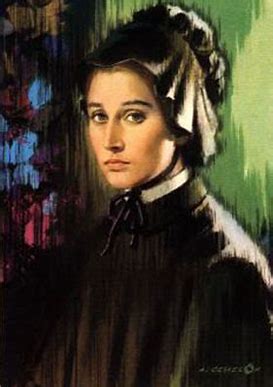
ELIZABETH ANN SETON
PATRON OF SEAFARERS AND WIDOWS
Saint Elizabeth Ann Seton is the first person born in what would become the United States to be canonized. She was born August 28, 1774, just before the Revolution began.
Elizabeth was the second daughter of Catherine Charlton, whose father was an Episcopal priest, and Dr. Richard Bayley. Dr. Bayley was the chief health officer for the Port of New York and the first professor of anatomy at Columbia College (later Columbia University). Her mother died when she was only three. Her father remarried. Her new stepmother was Charlotte Amelia Barclay. This woman was active in church social ministry, taking care of the poor and sick. She would take Elizabeth with her at times. Unfortunately, the parents separated after having five children and Charlotte rejected Elizabeth. Dr. Bayley went for a trip to London and left the two still young daughters with his brother in New Rochelle. Elizabeth wrote journals showing her love of nature, poetry, music and religion. The journals also reveal her sense of introspection and contemplation.
On January 25, 1784, Elizabeth married William Seton, a wealthy businessman whose partners were his brother and father. They moved to a fashionable residence on Wall Street. Elizabeth and her sister-in-law, Rebecca, continued the social ministry of Charlotte Barclay by nursing the sick and dying. Elizabeth became a charter member of the Society for the Relief of Poor Widows and Small Children in 1787.
Before 1800, the economic climate became bad. William’s father died and the company fortune began to wane. Elizabeth and Willian had to take in William’s younger siblings (six aged 6 to 17). With their growing family, they had to move to a bigger house. Unfortunately, a dispute grew between the US and France, which led to attacks on American shipping, including a number of William’s ships. The Setons went bankrupt. They lost their house. They moved in with Dr. Bayley, then moved to a small house. William had tuberculosis for years. The stress made it get much worse.
The doctors sent William to Italy, thinking the warm air would be good for him. Elizabeth, and their oldest, eight-year-old Anna Maria, went with him. He died soon after arriving, December 27, 1803. The poor widow went to stay with William’s Italian business partners. She was in no shape for a trip across the Atlantic at that point. While there, Elizabeth learned the Catholic Faith.
Returning to America, Elizabeth became a Catholic in two years and was confirmed a year later by the only Catholic bishop in America at that time, John Carroll. She had to support her children, who were all still young. So, she started a school for young ladies in her house. But the parents took their daughters out of the school once they heard that Mrs. Seton had become Catholic. By 1807, things were so tough that she was only boarding children who went to another school.
Things were so tough that Elizabeth thought of moving to Canada, when she met Abbe Dubourg. This priest was of the Sulpician order, and the president of St. Mary’s College in Baltimore. He dreamed of starting the first Catholic seminary in America. He also wanted a religious school near it.
In 1809, Elizabeth moved her family to Emmitsburg, Md. It was the middle of the woods! After a year of work, she opened St. Joseph’s Academy and Free School for Catholic Girls. She had no money, but a rich young convert financially supported this endeavor. On July 31 of 1810, Elizabeth also established a religious community of women dedicated to the care of children of the poor. They adopted the rules of Sisters of Charity. Elizabeth became known as Mother Seton.
Mother Seton only ran the community for ten years. During that time, she lost Anna Maria, at 17, her best friend and sister-in-law, Rebecca, only a year after moving to Emmitsburg, and Rebecca Mary, at 14. But she urged education and health care to be primary goals of the community.
Even though she lived to be only 46, in 1821, her dreams lived on. Within nine years of her death, there were orphanages and schools as far as Cincinnati and New Orleans, and a hospital in Saint Louis. There have been numerous schools and churches named in her honor since then.
When Pope John XXIII beatified Mother Seton in 1963, he commented, “In a house that was very small, but with ample space for charity, she sowed a seed in America which, by Divine Grace, grew into a big tree.”
St. Elizabeth is patron saint of widows, because she was one. But she is also patron saint of seafarers because her husband’s business required seafarers to move his products, and, probably, because, her sons joined the Navy soon after her death. Robert died at sea in 1823.

Recent Comments